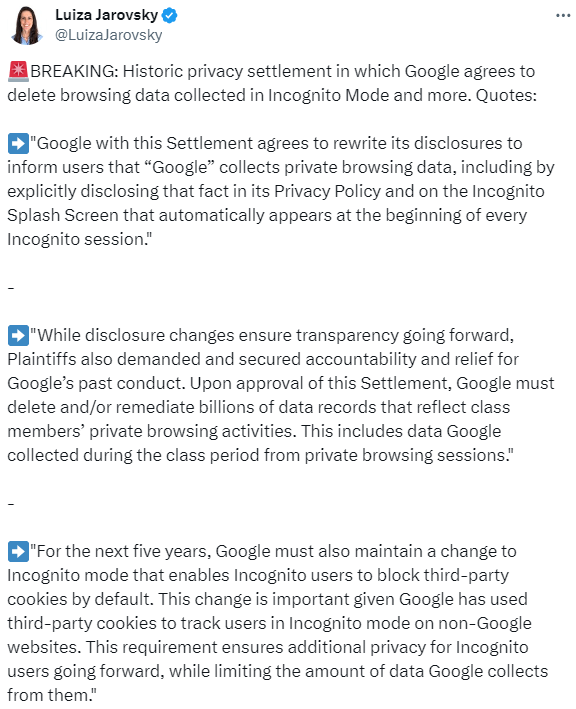
Google enhances privacy by wiping incognito browsing logs (Source – Shutterstock)
Unveiling the reality of incognito mode from Google and online privacy
- Google agrees to delete or anonymize incognito mode browsing data.
- In browsers like Google Chrome, Incognito mode provides limited privacy, failing to shield users from external tracking and data collection.
Incognito mode provides a semblance of privacy across widely-used web browsers, including Chrome, Safari, Firefox, and others. Marketed as a feature for browsing the web without saving your history on the device, it presents an illusion of complete privacy.
However, it’s commonly overlooked that, despite no record of activity being saved on the device, external entities — including website hosts, Internet Service Providers (ISPs), search engines, and various companies — can still monitor your online actions in incognito mode.
Legal spotlight: The Google incognito mode lawsuit
This oversight led to a lawsuit against Google for allegedly tracking users’ internet activity under the impression they were browsing privately. As a resolution, Google has agreed to either delete or anonymize billions of web browsing data records collected under its “Incognito mode”, as part of a class-action settlement proposal. This move follows allegations in a legal claim, suggesting that Google secretly monitored the internet activities of individuals who assumed privacy.
As reported by The Verge, the settlement of Brown v. Google necessitates that Google enhance its disclosure regarding data collection in Incognito mode and impose restrictions on future data gathering. Pending approval from a federal judge in California, this agreement could benefit approximately 136 million Google users who were implicated in the 2020 lawsuit. The lawsuit accused Google of illicitly tracking user activity via the private browsing feature.
The settlement’s value, pegged at US$5 billion, reflects the significance of the data Google is compelled to delete or prevent from gathering, dating back to December 2023 and before. Data that isn’t deleted outright will be stripped of identifying information.
Plaintiffs have heralded the settlement as a milestone in holding the “world’s largest data collector” accountable, viewing it as a vital step towards bolstering internet privacy rights.
In response, Google’s spokesperson José Castañeda expressed satisfaction over reaching a settlement for what the company views as a baseless lawsuit. Despite the plaintiffs’ valuation of the settlement at US$5 billion—the sum initially sought in damages—Castañeda pointed out that the actual compensation to the plaintiffs is nil, emphasizing the settlement’s exclusion of damages for the class. However, it allows for individual damage claims.

Google agrees to delete incognito mode data collected (Source – X)
Castañeda further clarified that Google does not link data to users in Incognito mode, and the company is ready to eliminate older, non-personalized technical data.
The agreement also mandates Google to update its privacy disclosures, a process it has already initiated on Chrome. For the next five years, Google will enable users to block third-party cookies by default in Incognito mode, thereby preventing Google from tracking their activities on third-party sites. Despite the settlement, individuals still retain the right to pursue claims for damages in California state court, with 50 claims already filed.
What incognito really means
Alright, let’s delve deeper into the specifics of what “incognito” mode actually means. We touched on it briefly earlier, noting that when you conclude a session in incognito mode, the browser doesn’t retain cookies or any traces of your visit.
Furthermore, incognito mode ensures that no data or search history from a specific session is saved on your device. This means that others who use your device can’t discover which sites you visited or what you searched for online.
To clarify, “incognito” implies concealing your identity. When you browse in incognito or private mode, you’re hiding your browsing activity from other users of the same device. However, it’s crucial to understand that your IP address and online actions are still observable to external parties.
In essence, private browsing shields your internet activities from the eyes of other users on your device, offering a layer of privacy from family and friends.
However, it’s crucial to recognize that Google Chrome’s incognito mode does not provide complete protection against tracking by websites or data collectors. As recent updates to disclaimers indicate, even in private browsing mode, websites can still accumulate data on your activities, including tracking by Google itself.
Furthermore, it’s significant to note that incognito mode may not conceal your activities from an employer or educational institution. So, if you’re trying to access websites discreetly at work or school, incognito mode might not offer the anonymity you seek.
Despite Google’s privacy policy stating that Incognito mode maintains privacy on your device, it doesn’t prevent Google from gathering data through other services, as detailed in their Privacy Policy.
Privacy vs. perception: The reality of digital anonymity
Though the concept of “incognito” suggests a level of anonymity, the reality does not fully align with the expectation of complete privacy. This gap between expectation and reality underscores a more significant issue in our digital society: the complex nature of online privacy and the oft-misunderstood mechanics behind it. Many users venture into incognito mode believing that it serves as a digital cloak, rendering their online activities invisible to all. Yet, this belief is a misconception that technology giants perhaps do not dispel clearly enough.
The truth is that incognito mode offers only a surface level of privacy protection, primarily against casual snooping on the same device. Contrary to popular belief, it is not a shield against the prying eyes of the broader internet ecosystem, including advertisers, websites, and internet service providers. This misunderstanding leads to a false sense of security, where users might engage in activities, thinking they are completely anonymous, only to leave digital footprints visible to a slew of online entities.
Moreover, the effectiveness of incognito mode—or the lack thereof—raises questions about the responsibility of tech companies in educating users about the scope of privacy their products actually offer. Is it enough to provide users with a tool that has limited privacy capabilities without making its limitations abundantly clear? This question becomes even more pertinent in light of the lawsuit against Google, suggesting a need for greater transparency and clearer communication from tech companies about what their privacy features can and cannot do.
READ MORE
- Safer Automation: How Sophic and Firmus Succeeded in Malaysia with MDEC’s Support
- Privilege granted, not gained: Intelligent authorization for enhanced infrastructure productivity
- Low-Code produces the Proof-of-Possibilities
- New Wearables Enable Staff to Work Faster and Safer
- Experts weigh in on Oracle’s departure from adland




